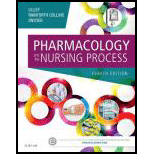
To review:
The functions of the sympathetic nervous system and the specific effects of adrenergic-blocking drugs.
Introduction:
The central nervous system (CNS) and peripheral nervous system (PNS) are considered as the two important branches of the nervous system. The CNS consists of the spinal cord and brain, whereas the PNS contains autonomic (ANS) and somatic nervous system (SNS). The ANS is further divided into the sympathetic or adrenergic and parasympathetic or cholinergic.
Explanation of Solution
Functions of the sympathetic nervous system:
Adrenergic compounds are involved in the therapeutic effects with the help of their receptors. They stimulate the SNS and it is known as adrenergic agonists. They are also known as sympathomimetic because they mimic the SNS neurotransmitters effects such as norepinephrine, dopamine, and epinephrine. These neurotransmitters are classified in terms of chemical nature as catecholamines. The G-protein coupled adrenergic receptors targets the catecholamines neurotransmitters such as epinephrine (adrenaline) and norepinephrine (noradrenaline). These adrenergic receptors of the SNS provide the check and balance system to maintain the body homeostasis.
Specific effects of adrenergic-blocking drugs:
The adrenergic-blocking drugs cause the opposite effects with the adrenergic agonist drugs. They block the stimulation of sympathetic nervous system neurotransmitters and it is known as adrenergic antagonists. The specific effect is to bind the adrenergic receptors and inhibit or block the stimulation effect of the SNS. It is termed as sympatholytics.
The adrenergic-blocking drugs are classified into alpha and beta-adrenergic blockers.
Alpha-adrenergic blocking drugs: It blocks the adrenergic effects of norepinephrine that leads to vasodilation, miosis and reduces the blood pressure and tone of smooth muscles of the prostate and bladder.
Beta-adrenergic blockers: The blocking of beta-adrenergic antagonists are non-selective and cardio-selective in nature. They allow more supply of oxygen to the heart muscle by decreasing the oxygen consumption and myocardial energy in the body system.
Thus, the functions and specific effects of adrenergic antagonists include the blocking of SNS receptors stimulation.
Want to see more full solutions like this?
Chapter 19 Solutions
Pharmacology and the Nursing Process, 8e
 Phlebotomy EssentialsNursingISBN:9781451194524Author:Ruth McCall, Cathee M. Tankersley MT(ASCP)Publisher:JONES+BARTLETT PUBLISHERS, INC.
Phlebotomy EssentialsNursingISBN:9781451194524Author:Ruth McCall, Cathee M. Tankersley MT(ASCP)Publisher:JONES+BARTLETT PUBLISHERS, INC. Gould's Pathophysiology for the Health Profession...NursingISBN:9780323414425Author:Robert J Hubert BSPublisher:Saunders
Gould's Pathophysiology for the Health Profession...NursingISBN:9780323414425Author:Robert J Hubert BSPublisher:Saunders Fundamentals Of NursingNursingISBN:9781496362179Author:Taylor, Carol (carol R.), LYNN, Pamela (pamela Barbara), Bartlett, Jennifer L.Publisher:Wolters Kluwer,
Fundamentals Of NursingNursingISBN:9781496362179Author:Taylor, Carol (carol R.), LYNN, Pamela (pamela Barbara), Bartlett, Jennifer L.Publisher:Wolters Kluwer, Fundamentals of Nursing, 9eNursingISBN:9780323327404Author:Patricia A. Potter RN MSN PhD FAAN, Anne Griffin Perry RN EdD FAAN, Patricia Stockert RN BSN MS PhD, Amy Hall RN BSN MS PhD CNEPublisher:Elsevier Science
Fundamentals of Nursing, 9eNursingISBN:9780323327404Author:Patricia A. Potter RN MSN PhD FAAN, Anne Griffin Perry RN EdD FAAN, Patricia Stockert RN BSN MS PhD, Amy Hall RN BSN MS PhD CNEPublisher:Elsevier Science Study Guide for Gould's Pathophysiology for the H...NursingISBN:9780323414142Author:Hubert BS, Robert J; VanMeter PhD, Karin C.Publisher:Saunders
Study Guide for Gould's Pathophysiology for the H...NursingISBN:9780323414142Author:Hubert BS, Robert J; VanMeter PhD, Karin C.Publisher:Saunders Issues and Ethics in the Helping Professions (Min...NursingISBN:9781337406291Author:Gerald Corey, Marianne Schneider Corey, Cindy CoreyPublisher:Cengage Learning
Issues and Ethics in the Helping Professions (Min...NursingISBN:9781337406291Author:Gerald Corey, Marianne Schneider Corey, Cindy CoreyPublisher:Cengage Learning





